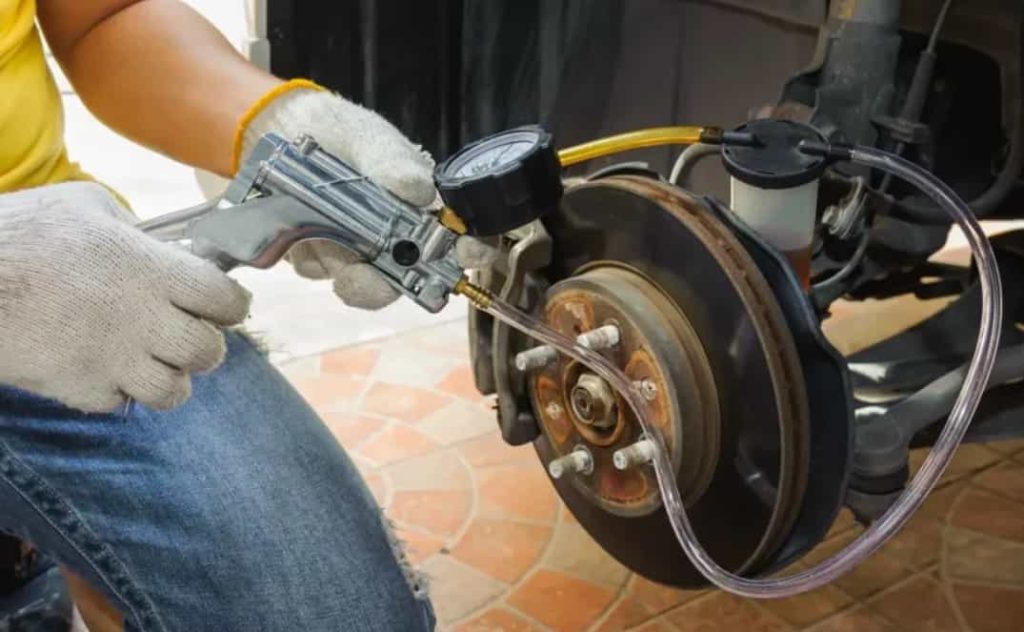No brake fluid coming out when bleeding can be concerning for most people.
After all, the process of bleeding air out of your brakes is already a tiring thing to do. So it is even worse when nothing seems to be making any difference. But there are always certain things you can check such as a clog in your bleed valve. It is usually the first thing to look into before trying out other things.
Now, if you experience the absence of brake fluid coming out during the bleeding process, there are a number of issues leading up to this problem. Perhaps, you have cracked hoses, caliper problems, or your brake lines are blocked.
The right fix always starts with determining the actual cause of the problem. By doing so, it should be much easier to perform the best solution.
Today, we will talk about this problem of no brake fluid coming out when bleeding and the most appropriate way to deal with it. Let’s jump right into it.

Causes Of No Brake Fluid Coming Out When Bleeding
Before you perform checks in determining the possible cause of no brake fluid coming out when bleeding, it helps to start by taking off your brake oil filler cap. Moreover, you need to bleed your brake first as it is farthest from your master cylinder. Then, you can slowly go toward it.
Thus, the proper order is from the passenger side rear, then to your driver side rear, followed by the passenger side front and then the driver side front.
Additionally, if you use a gravity bleeding method, keep in mind that this takes about half an hour before you may see the brake fluid coming out.
When you have replaced your master cylinder and you are beginning from a completely dry brake system, bleeding can take a very long time. This is why we recommend the vacuum bleed or pressure bleed method for best results.
Now, as we have mentioned earlier, there are many causes of a no brake fluid coming out when bleeding issue.
First, you may have a clogged bleed valve. Since your brakes do not get so much servicing except for getting the brake discs and pads replaced, it is typical for the system to collect debris and contaminants.
If there is no rubber cap over the bleed valve, it is highly likely for a clog to be present. Therefore, you need to start by checking your bleeding valve. Certain tools are required to perform this process such as your brake cleaner, wrench set, and a small metal pick or cleaning brush for pipes.
Check if the issue is indeed the bleed valve. You need to first take this out from your brake caliper and check if you see brake fluid coming off of this part. Hold your finger right on the hole to tray bleeding the fluid. If you see the brake fluid come out, all it needs is a simple cleaning of your bleeding valve.
Use the brake cleaner and scrub the inside using your pipe cleaning brush. Continue doing this until you see the brake cleaner flowing through your bleed valve.
Another possible cause of no brake fluid coming out when bleeding is a blockage in your brake caliper. This is not a common cause since you should have already noticed some symptoms while driving.
But you should not dismiss the possibility of this issue since it can most definitely happen. It is possible that when initiating the bleeding process, there was some debris that went into the caliper through the master cylinder. This is why we highly recommend checking the caliper first since it is also likely that you have clogged hoses.
For this process, you will need a WD40, wrench set, and an air compressor. Remove your brake hose to inspect if the brake caliper has a problem. You may notice that there is a metal pipe attached to your brake caliper. If so, avoid breaking or bending it – simply spray on some rust remover.
Then, check if there is oil bleeding out of your hose. Continue bleeding and then blow compressed air into your caliper if the oil still comes out. Be sure to unfasten your bleed valve to make sure there is air flowing through it.
But if there is no oil flowing out, the next step is to check your brake lines for blockages. It is possible that there is dirt and debris in the brake lines, which is preventing the brake fluid from coming out when bleeding.
After removing the hoses, open your brake oil filler cap. Then, blow compressed air right into your brake line. Do this carefully since you would not want to blow too much air as it is difficult to remove this afterward. The only thing you need to focus on is to take any clog out by moving it along. A quick burst of air should do it.
We also like to recommend checking if you see oil going back into your reservoir. If you don’t see it, the metal portion of your brake lines may have collapsed because of rust.
Another thing we would like to add is the possibility of brake lines leaking. It is pretty much straightforward to do this. This is an important thing to do since the hole may be present, yet it is too small for you to see. Thus, be sure to inspect the entire length of your brake line. If you see any crack or hole, you need to replace the piping or hose. Otherwise, it is a major safety risk to continue driving.
Read More: Expert Tips On Temporary Fix For Crankshaft Position Sensor
Bottom Line
There are many causes of no brake fluid coming out when bleeding. To come up with a definitive solution to this problem, it is best to determine the reason behind this problem. Then, you can perform the right technique to resolve this issue once and for all.